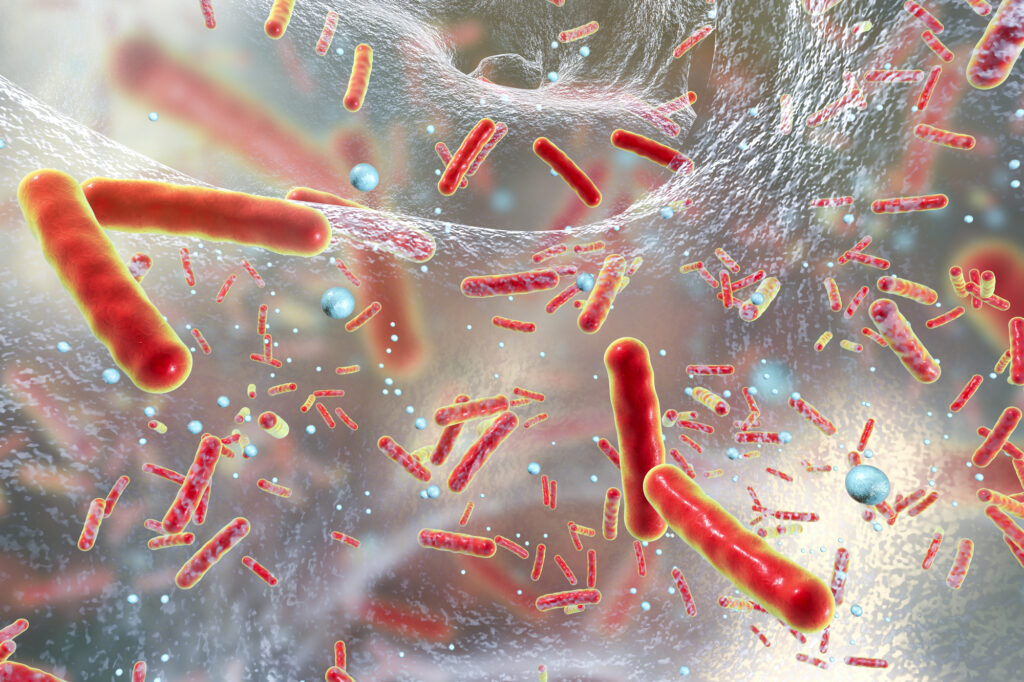While some antibiotics target specific bacteria, many are broad-spectrum, meaning they can kill a wide range of bacteria including bad bacteria that cause infections and good bacteria that live in our guts and help with digestion and other processes.
Carbapenems are strong, broad-spectrum antibiotics often used as a last resort due to their negative impacts on beneficial bacteria. But some pathogenic bacteria in the class Enterobacteriaceae are even resistant to carbapenems, including several strains of E. coli. These bad bacteria colonize the gut but can spread to other sites in the body, causing difficult-to-treat infections, including infections of the bloodstream and urinary tract.
Now, a new study shows how these resistant bacteria thrive after antibiotic use, allowing them to multiply in the gut and form a reservoir of disease-causing bacteria. The results were published in the journal Nature Communications in August.
The Study
To determine the effect of antibiotics on the gut microbiome—the collection of microorganisms that live in the human digestive system—a team led by researchers from Imperial College London collected fecal samples from healthy adults between the ages of 18 and 65 who had not received antibiotic treatment for more than six months prior to the investigation.
The researchers then measured the effects of applying eight broad-spectrum antibiotics to the fecal samples. Each participant’s sample was divided to seed nine tests—eight segments treated with the antibiotics and one untreated.
The results showed that when the antibiotics killed beneficial bacteria, the pathogenic bacteria were able to take advantage of the extra nutrients available due to less competition. Killing beneficial bacteria reduced the level of metabolites in the samples—waste products that inhibit pathogenic bacteria from growing. All told, antibiotics that killed off beneficial bacteria unintentionally helped the antibiotic-resistant pathogenic bacteria to thrive.
Conclusions
In the short term, the researchers say, their results could be used to help reduce the risk of patients harboring reservoirs of carbapenems-resistant Enterobacteriaceae (CRE) in their guts. For example, doctors could screen patient fecal samples for the nutrients and metabolites observed in the study to identify patients at increased risk of CRE colonization.
Longer-term, the Imperial College team is hoping to develop ways to interfere with this process, perhaps by identifying beneficial bacteria that can out-compete pathogenic bacteria in the absence of antibiotics—strains of good bacteria that make better use of the same nutrients and produce metabolites that restrict pathogenic bacterial growth.
With this information, they hope to create what they call “microbiome therapeutics” to control CRE. “When a patient is taking antibiotics we could give them inhibitory metabolites to restrict the growth of resistant bacteria,” explained lead researcher Julie McDonald, PhD, of the Department of Life Sciences at Imperial College. “After a patient has stopped taking antibiotics, we could give them a mixture of beneficial gut bacteria to help their gut microbiome recover.”
According to McDonald, these therapies could have a wide range of beneficial effects. “[M]icrobiome therapeutics could reduce the risk of patients developing invasive antibiotic-resistant infections, reduce the recurrence of invasive CRE infections…and reduce the spread of CRE to susceptible patients,” she said.






